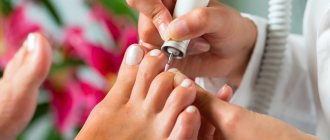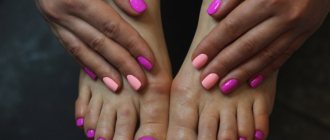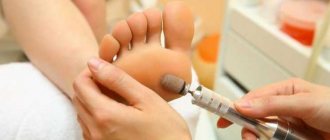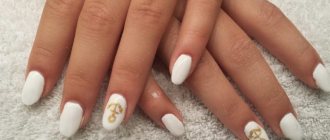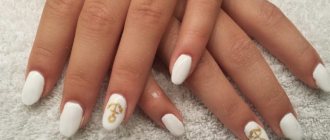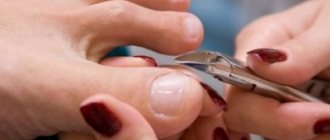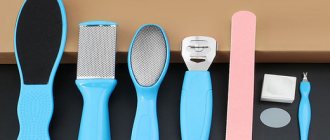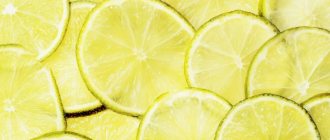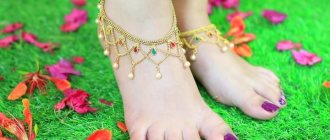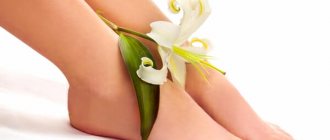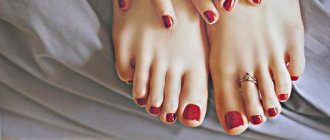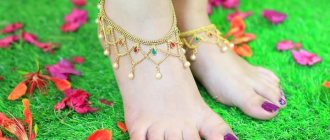14.12 2021
Author: Anna
Topic: Well-groomed nails
Hello, dear readers!
Every modern girl tries to take care of her feet. After all, they should always be neat, beautiful and well-groomed. Therefore, nail service specialists today offer the fair sex several types of pedicures, from traditional to innovative. They differ in different execution techniques, retention time of the effect, and pricing policy.
At the same time, those young ladies who come to the salon for the first time may be confused about which pedicure is better, classic or hardware. After all, this issue must be approached wisely. And it is right.
Since, for example, in women with diabetes, a traditional pedicure can cause serious problems, including gangrene. But experts do not recommend hardware technologies for pregnant women.
Why so, how to find the right solution? To do this, I will tell you in a little more detail about the features of these procedures, their positive and negative aspects, so that everyone can choose the best option for themselves.
- 1 Features of traditional foot care techniques 1.1 Pros and cons
- 2.1 Pros and cons
What is a hardware pedicure
Hardware pedicure is a mechanical treatment of the skin of the foot, nails and toes using a special grinding tool with cutters and various attachments. The device, due to the rapid rotation of the cap, safely removes keratinized epithelium, corrects the nail bed, polishes the nail plates and removes cuticles.
The pedicure device has several operating modes, adjustable to different power and speed depending on the condition of the skin. After each session, removable attachments are treated with an antiseptic, ensuring absolute hygiene.
Features of hardware pedicure
The main feature of this treatment is the treatment of dry skin without prior steaming. The dead layer of epithelium is removed gradually in exactly the amount that is acceptable for the current condition of the feet.
Other features include:
- efficiency - different attachments not only tidy up nails, but also remove corns and calluses, leaving the skin smooth and soft;
- versatility - the device can be used even on sensitive skin without the risk of damage or fungal infection;
- the presence of a professional master - only a trained master can carry out the procedure correctly;
- therapeutic effect - hardware care eliminates cracks and ingrown nails.
Which pedicure is better: European, hardware or classic?
It’s impossible to say which pedicure will suit you better: edged or hardware, or maybe even a European one. This is a matter of personal preference, and, of course, the characteristics of the skin on your legs. Now that you know their main differences, making the right choice will be much easier, but the advice and opinion of the master should not be ignored either. And it will be even better if you visit each type of pedicure, listen to your feelings, evaluate the result - and then with complete confidence you can choose the procedure that you liked the most according to all the criteria.
The main differences between classic and hardware pedicure
Both classic and hardware pedicures are considered the most popular in beauty salons. Their differences are as follows:
- Performance technique. For hardware care, you need a special tool with attachments, each of which performs a specific function. For the classic one, a set of tools is required, consisting of pumice, scraper, tongs, etc.
- Steaming. It is only necessary in the classic version. In a pedicure with a device, the skin is softened with special lotions and gels.
- Application of the trimming method. Only in the classical procedure is the skin cut off, increasing the risk of injury and infection with fungal diseases.
- Price. Hardware pedicure is much more expensive.
- Duration of effect. When treating feet with a sanding device, the skin remains smooth on average 2 weeks longer.
Sports pedicure
The main goal of a sports pedicure is to make training as comfortable as possible. In this type of pedicure, the main thing is not beauty, but expediency. Nails are trimmed to prevent injury. Specialists give priority to the treatment of cracks, bruises of the feet and other injuries. Prevention of fungal diseases is very important: after all, athletes move intensively in closed shoes for a significant part of the day. To normalize blood circulation, the legs are massaged, and athletes are given means to prevent excessive foot sweating.
Pros and cons of hardware pedicure
The advantages of such care include:
- Safety. During the procedure, contact with sharp objects is excluded, thereby reducing the likelihood of cuts and infection through them with infectious diseases.
- Sterility. Before work, the master treats his hands and all tools with antiseptic agents. If disposable devices are used, they are in a sterile bag and opened in front of the client.
- Lack of water. To soften the skin, keratolytic substances (ointments, creams, lotions) are used, which, in addition to their main function, also have a tonic effect.
- Lasting results. The attachments remove only the stratum corneum of the epithelium without damaging the healthy one. Regeneration processes do not start, and the skin grows slower.
- Speed of the procedure. Treatment of nails with the device is carried out relatively quickly.
- Painless. The rotation of the cutters and attachments feels like a light massage. Only very sensitive skin may experience slight discomfort.
- Minimal contraindications. Hardware pedicure is suitable for different conditions of the feet and is contraindicated only for people who are allergic to the components of metal attachments.
This method of foot treatment has significantly fewer disadvantages:
- high price in showrooms due to the cost of the device itself and consumables;
- if you don’t have a tool and/or experience working with it, you won’t be able to do such a pedicure at home;
- people with sensitive skin experience a burning sensation during the procedure.
Comparison of two methods
The table shows the main characteristics of each method:
| Classic pedicure | Hardware pedicure |
| Quite complicated to execute, does not always look perfect Requires the use of numerous devices One session takes about 1-1.5 hours It is considered traumatic and requires extreme caution from the master. Has a number of contraindications in the form of various diseases The average cost is 400-700 rubles. | Easier to perform and looks aesthetically pleasing Carried out according to a simplified scheme Takes no more than 15 minutes, saves time Rarely leads to damage to the skin, side effects There are practically no restrictions on carrying out The price of the service in domestic salons starts from 1000 rubles. |
Types of hardware pedicure
There are several types of hardware pedicure, differing from each other either in the method of processing cuticles or in the number of additional cosmetic procedures.
Classic pedicure
Classic treatment includes standard treatment of the sole of the foot, skin folds, fingers and toenails with rotating caps. Dead epithelium and cuticle are removed, a nail bed is formed, the surface of the nail is polished, after which a decorative or medicinal coating is applied to it. Finally, the leather is treated with finishing agents.
Unedged pedicure
Since all hardware pedicures are essentially unedged, this term is more of a nominative nature. During the procedure, the cuticle is not processed by the device, but is only moved with a wooden stick. To make it more pliable, the master first lubricates the surface with softening oils, and only then forms the nail bed.
This type of care prevents damage to healthy skin, but the effect does not last long: after just 2 weeks, the cuticles again look untidy and require treatment. If pushing back and softening with oils is carried out systematically, a cumulative effect is achieved - the cuticles become softer.
SPA pedicure
The essence of the procedure is relaxation after a hardware pedicure. When the treatment of feet and nails is completed, the following is done:
- foot baths with the addition of flavored oils, plant extracts, sea salts, thermal waters;
- peelings with natural scrub;
- various masks based on natural ingredients, vitamin complexes;
- relaxing massage.
How does a medical pedicure differ from a regular pedicure?
The classic procedure has no special indications - it is done at will. But a pedicure from a podiatrist is usually offered in two cases: if you are concerned about a certain problem related to the health of your feet and nails, or as a preventive measure.
Instagram content
This content can also be viewed on the site it originates from.
Indications for the procedure
In some cases, the choice between classic and hardware pedicure is a matter of health. Processing with cutters and attachments is necessary when:
- hangnails - removing them with forceps will be difficult and traumatic;
- thin cuticles - ordinary tools damage it, causing pain for several weeks after a pedicure, and the device carefully removes it;
- uneven surface of the nail - polishing with attachments smooths out the bumpy surface, makes the thick nail plate thinner;
- diabetes mellitus – only a device can quickly improve the legs of people suffering from diabetes;
- damaged nails - special attachments correct any imperfections;
- ingrown nails - cutters not only treat ingrown nails, but are also considered its main prevention;
- cracks, corns, calluses - dealing with them manually is more difficult and takes longer.
Contraindications to the procedure
There are practically no contraindications to hardware pedicure. The only diagnosis for which it is prohibited is an allergy to the components included in the products used. You can try to select other materials, but the choice is not so large, and most of them have approximately the same composition.
For certain situations, a thin and weakened nail plate will also be a contraindication. Milling cutters may damage it during processing. However, experienced craftsmen know what attachments to use in this case and how to avoid injuries.
Milling cutters
The classic set of an experienced master for performing a hardware pedicure should contain 4 main cutters: a cone, a ball, a needle, grinders and polishers for feet of various levels of hardness.
The rigidity of the cutter is determined by the cut. Three colors are suitable for pedicure – green, blue and red. Cutters with green notches and diamond coating are for rough skin, cutters with blue ones are the most popular for working with the skin of the cuticle, sinuses and sinuses of the nail, with red ones for working with the skin and sometimes the nail plate. They are considered soft. The yellow notch indicates the softest cutters with which you can safely work on natural nails.
How to choose a master?
The choice of a pedicure specialist is the main point on which the quality and comfort of the procedure depends. To find “your” master, you need to follow simple recommendations:
- Trust only proven salons with a good reputation, where it is clear at the entrance that sterility and hygiene are not just a sound.
- Be wary of home professionals who offer pedicures at ridiculous prices. Firstly, at home he receives many self-taught people who bought the device and immediately decided to make money from it. Secondly, too low a cost indicates the use of cheap, low-quality materials.
- Check that the specialist has documents confirming his qualifications - diplomas, certificates.
- Study reviews about the master on various resources. Both positive and negative reviews can be ordered online. If you visit several sites, you can get a more or less objective idea of the quality of services.
- Consult with friends. You should only trust those whose legs look the way you really would like. Some people tend to consider themselves competent in all beauty issues; their reviews should be treated with caution.
Also a good master:
- he cannot do only a hardware or only a classic pedicure - he knows all the methods and chooses the treatment method himself, based on the characteristics of the feet;
- does not follow the client’s lead and does not do something harmful - for example, it is impossible for a 35-year-old person to do “heels like a baby’s”, even if he tearfully asks (after this it will be painful to step on the foot for a week, and a new layer will grow in 2 times faster);
- does not impose unnecessary procedures and means - if he offers something, he argues why the client needs it.
You should feel comfortable in the company of the chosen master. A pedicure is not done in 5 minutes, so a good atmosphere will be the key to a pleasant time.
Device for hardware pedicure
The treatment of feet and toes is carried out with a special tool with various attachments, cutters and caps. The devices differ in technical characteristics:
- Power. Devices with ratings above 35 W can withstand constant load and are suitable for pedicures, manicures, removing old coating, and cutting down artificial nails. Lower power is intended for occasional home use.
- Rotational speed. The number of revolutions per minute is adjusted by the master depending on the operation being performed, but the figure should not be lower than 25,000 rpm. Otherwise, even processing the cuticles will become a problem.
- Foot control. The pedal allows the master to free his hands during the procedure.
- Reverse. The nozzles rotate both clockwise and counterclockwise, performing their functions better.
Compact devices are available for home use, and more massive, powerful options for working in the salon.
Attachments for hardware pedicure
The attachments are used for skin, cuticles, natural and extended nails. They differ in diameter, rotation speed and rigidity. Nozzles are made from different materials:
- Ceramic. The safest ones are a mixture of abrasive and adhesive. There are coarse-grained (for removing keratinized epithelium on the feet), medium-grained (for processing cuticles), and fine-grained (for grinding the nail plate and skin ridges). Such attachments wear out quickly.
- Diamond. They last longer than ceramic ones. They are made from glue and diamond chips and vary in diameter. The hardness of the nozzle is determined by the color stripe on the rod: black - high, blue and green - medium, red and yellow - low.
- Metal. They are produced by applying notches to hard metal tips. They are used to remove a large layer of dead skin, file away thick coverings, and remove corns and calluses. They are convenient because they do not create dust.
- Silicone. Made of silicone and abrasive particles designed for grinding and polishing. Coarse-grained nozzles of dark colors are used to polish the sole of the foot, and medium- and fine-grained ones are used to polish nails.
- Natural. They contain fibers of plant materials that gently polish the nail and give it a natural shine.
Caps for hardware pedicure
The cap is a replaceable part made of rubber (inner part) and abrasive (upper part). The caps remove keratinized epithelium and polish the soles of the feet. They can be of different shapes:
- cylindrical;
- pointed;
- rounded.
Only dry skin can be treated with tips. The material cannot be disinfected after each use. The caps wash quickly and are inexpensive. The choice of a specific attachment depends on the condition of the client’s skin, the volume and type of work to be done.
Cutters for hardware pedicure
Milling cutters are a tip with several cutting blades and teeth, made of steel with the addition of abrasives. Its purpose depends on the shape of the cutter:
- ball - for caring for nail grooves;
- cylinder - for removing dead skin, calluses and corns;
- ellipse – for treating core calluses;
- cone – for treating ingrown nails and cleaning hard-to-reach places;
- disc - for polishing the nail plate, giving shape.
The final result depends on the quality of the cutters.
Alternative types of toe treatments
Liquid chemical
This method of foot treatment is considered an express method. It is based on the use of chemicals that contain alkalis or acids; in form it can be a gel, cream, or emulsion. The skin softens in just a few minutes, after which it is easy to remove.
Urea
If the feet are affected by corns or hyperkeratosis, then it is rational to use urea (urea) to treat them. The small size of the molecules of this substance promotes deep penetration into the layers of dead skin and softens it.
Urea can enrich tissues with useful substances, and it is also a good moisturizer.
Sequence of procedure:
- An antiseptic spray is applied to the skin of the feet;
- followed by treatment with urea;
- time for five minutes, after which the softened epidermis is removed with a spatula or napkin;
- the feet are given a neat appearance by sanding;
- The nail plates are polished and varnished.
Gel
This subtype of pedicure can be alkaline, acid, or urea. The main thing is that the product that is used has a gel consistency. In this form, it does not flow from the surface of the skin and is easily removed - it’s convenient.
Many people enjoy spa treatments as an alternative to regular pedicures. It is worth paying attention to them, perhaps they will add a special charm.
What skin types will you work with?
The choice of attachments and operating parameters of the device depend on the condition of the skin of the feet. The master himself assesses the amount of work and sets up the device. Each skin type has its own characteristics that affect the procedure.
Normal foot skin
Such feet are characterized by slight roughness in the heels and outer lateral part of the sole. Corns may form in the summer due to dirt and dust that gets into open shoes. In most cases, pedicure is limited to polishing; cutters are rarely used. The result lasts for at least 3 weeks.
Medium foot skin
A more problematic type, characterized by a tendency to dryness. It is considered the most common in our climate zone. The skin becomes yellowish due to the thick stratum corneum; if not properly cared for, calluses and cracks appear. The procedure takes longer and requires grinding. The effect lasts for an average of 2 weeks.
Problematic foot skin prone to damage
Due to increased dryness, the soles of the feet become covered with cracks, calluses, and become very flaky. It hurts to step on a person's feet. One treatment procedure is not enough. Every week and a half, you can restore the health of your feet with the help of the device and correctly selected attachments. The master also gives recommendations for home health improvement.
Step-by-step instructions for a hardware pedicure
The procedure takes a long time and is carried out in several stages:
- The treated areas are lubricated with an antiseptic to prevent infection.
- If the nail plates are long, they need to be trimmed with tweezers or scissors.
- A softening keratolytic is applied to the skin of the foot and rubbed in for several minutes until the hardened epithelium becomes pliable.
- If your feet are not clean enough, they should be placed in a bath of cool water so that they do not have time to steam, but are cleansed.
- The master puts on a mask and goggles.
- Use a paper towel to remove any remaining softening gel from your feet.
- The feet are treated first. First, a coarse-grained cap with an abrasiveness of 60/60 is taken, the rotation speed is set at around 10-12,000 rpm.
- Then the nozzle is changed to a fine-grained one with an abrasiveness of 100/100 for further polishing. Treatment is complete when the skin turns pink with a slight yellowish tint.
- The feet are moistened with water, and all excess is removed from them.
- Next the fingers are polished. A keratolytic agent is applied to the areas between the fingers and wiped off. The nozzle is changed to a cone-shaped one made of blue or blue ceramic, and the softened skin is processed.
- A pink or red cutter with a smaller grain size is installed, and the skin on the fingers is sanded.
- Special oil is applied to the cuticles and side ridges, then the latter are carefully processed at low speeds (up to 6,000 rpm).
- The nozzle is changed to a diamond-coated ball nozzle. The cuticle is polished (easily, without pressure).
- A felt cap is installed and the nail plates are polished to a shine.
- A natural-based moisturizer is applied to the entire surface of the feet.
Classic pedicure
A classic pedicure, or trim, is carried out using cutting cosmetic instruments: blades, scissors, various types of tweezers. Before treatment, the skin of the feet must be softened in warm water.
Technique
The technique of classic pedicure has remained unchanged since its invention and consists of the following stages:
- Washing feet, disinfecting, removing old nail polish.
- Steaming rough skin of the feet in a bath.
- Removing the cuticle (cut it off), cleaning and trimming the nails.
- Removing softened roughness from the feet (using cutting instruments).
- Sanding leather with pumice.
- Foot massage, application of nourishing cream.
- Nail design (at the client’s request, additional service).
Advantages
There are few advantages to a classic pedicure, the main ones being the affordable price and ease of implementation. For a trim pedicure, you do not need to buy complex devices or equipment, so the technique remains very popular for home use.
Beauty salons are increasingly abandoning classical technology, as it has a lot of disadvantages.
Flaws
Key disadvantages of trim pedicure, which serve as a reason for refusing to perform it:
- Soreness
- unpleasant sensations may appear during skin treatment or after a pedicure, since on softened skin not only dead horn cells, but also living tissue are easily removed. - Risk of Cuts
– There is no guarantee that sharp instruments will not cause cuts to the skin. - Threat of infection – steamed skin becomes more susceptible to fungal and bacterial infections; if hygiene rules are not followed and cuts occur, the risk of infection increases.
- “Thin skin”
- when working with cutting tools, the master cannot control the thickness of the removed and remaining stratum corneum, so he removes too much. The day after the pedicure, a feeling of thinning skin appears, and discomfort is felt when walking. - Short-term results
- active cutting of the stratum corneum stimulates the growth of new cells, as the skin includes a protective and regenerative mechanism. Therefore, in a week you will need to do a pedicure again.
What actions after the session?
Immediately after the procedure, you need to let your feet rest and absorb the cream. Then you can apply a decorative coating to your taste. If the specialist has given recommendations for home care, they must be followed. Evening foot baths and masks will not be superfluous, they will prolong the smooth effect and relieve fatigue.
Between trips to the salon, you can file your nails yourself, using a file from the edge to the center strictly in a straight line. It is undesirable to touch the corners of the nail - this can lead to ingrown nails.
Expert opinions on hardware pedicure
Nail service experts consider hardware pedicure an excellent alternative to trimming, since it does not damage the living layers of the skin, but only removes rough ones. Here is how Marina, a top manicure and pedicure specialist, speaks about the procedure: “Classic pedicure traumatizes the skin, after which the corns begin to grow again with a vengeance. Treatment with the device allows you to remove only dead epithelium, the smooth effect lasts many times longer. Regularity is an important point. If you do pedicures regularly, after a couple of months your legs will noticeably transform. In addition, hardware pedicure is great for pregnant women and people with diabetes.”
What to choose?
If you are wondering which type of pedicure to choose, here are a few things to consider before making your final decision:
- The presence of a number of diseases or problems with the legs - given the fact that a classic pedicure uses preliminary steaming, it is better to avoid this procedure for those who suffer from varicose veins, thrombosis, diabetes (however, this is not due to steaming, but to possible microtraumas). In these cases, it is better to give preference exclusively to the hardware option. By the way, it is the latter that is indicated in the presence of nail fungus: the procedure allows you to delicately and thoroughly remove the affected part of the nail, thereby shortening the period of treatment and restoration of its surface.
- Thin skin – for those who are worried about possible injuries and are afraid of “catch” an infection due to them, perhaps a hardware pedicure can also be considered a good option.
- If you want to relax and have fun - a classic pedicure with SPA elements is an ideal solution for those times when you want to enjoy the procedure - a leisurely foot treatment and a gentle massage will give you real pleasure.
Pedicure ideas
The final stage of the procedure is coating. Since toenails grow slower than those on the hands, the decor of the nail plates will please its owner longer. A few ideas for a beautiful pedicure:
- monochromatic classics emphasize style; bright colors are especially popular in the summer;
- the matte finish goes well with various nail art techniques on several fingers - stamping, “broken glass”, “cat’s eye”, etc.;
- French and lunar pedicures always look neat and sophisticated, suitable for any time of year;
- thematic designs such as marine style, floral patterns, geometric shapes, fashionable prints speak of the originality and good taste of their owner;
- rhinestones, sparkles, and stones add luxury to the look.
Hardware pedicure is a good way not only to tidy up your nails, but also to improve the health of your entire foot. Safety, efficiency, speed of implementation - thanks to these characteristics, this type of care wins over the classic trim pedicure.
